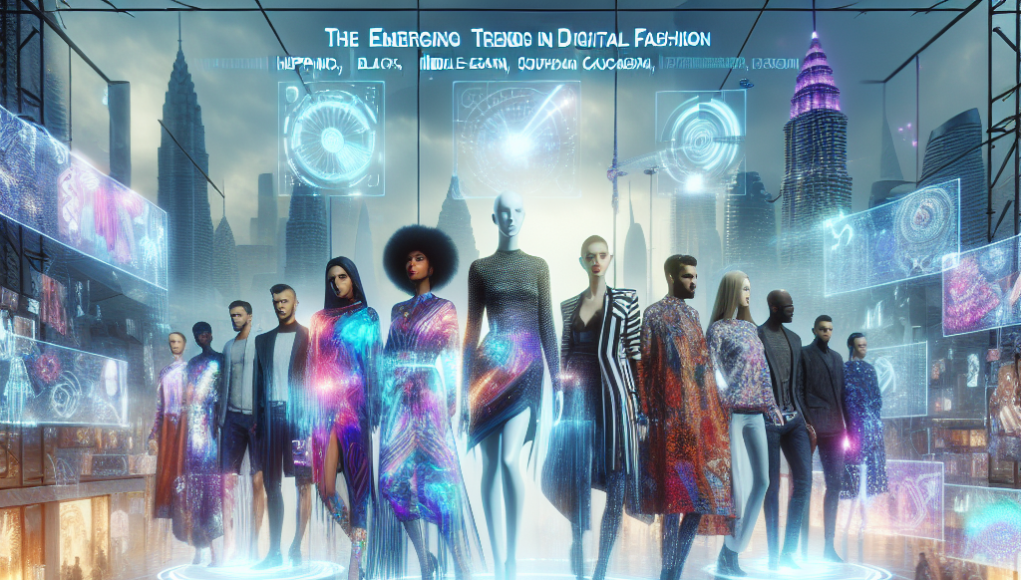The digital fashion world is undergoing a transformative journey, reshaping how we perceive style, design, and ownership in the virtual realm. As technology continues to evolve, the fashion industry is embracing new digital trends that are redefining the boundaries of creativity and consumer engagement. This article explores the emerging trends in digital fashion, focusing on the rise of virtual fashion platforms, innovations in digital clothing design, and the role of NFTs in fashion’s future.
The Rise of Virtual Fashion Platforms
The digital fashion landscape is witnessing a significant shift with the emergence of virtual fashion platforms. These platforms provide a space where designers and consumers can interact in a purely digital environment, free from the constraints of physical materials and geographical boundaries. Virtual fashion platforms allow designers to showcase their creations in 3D environments, offering consumers a unique and immersive experience that was previously unimaginable.
One of the most notable aspects of virtual fashion platforms is their ability to democratize fashion. By removing the need for physical production, these platforms enable designers from all backgrounds to present their work to a global audience. This shift not only broadens the scope of fashion but also encourages diversity and inclusivity within the industry. Emerging designers can now gain exposure and recognition without the traditional barriers associated with the fashion world.
Additionally, virtual fashion platforms are revolutionizing consumer engagement by offering interactive and personalized experiences. Users can virtually try on clothing and accessories, experimenting with different styles and looks before making a purchase. This level of interactivity enhances the shopping experience, making it more engaging and tailored to individual preferences. As a result, consumers are more likely to make informed decisions, leading to higher satisfaction and reduced returns.
Moreover, these platforms are playing a crucial role in promoting sustainability within the fashion industry. By eliminating the need for physical production, virtual fashion reduces waste and minimizes the carbon footprint associated with traditional manufacturing processes. This aligns with the growing consumer demand for sustainable and eco-friendly fashion options, further driving the adoption of virtual fashion platforms.
The rise of virtual fashion platforms is also fostering collaborations between fashion and technology companies. By leveraging advanced technologies such as augmented reality and artificial intelligence, these platforms are pushing the boundaries of what’s possible in digital fashion. This collaboration is leading to the development of cutting-edge tools and features that enhance the user experience, creating a seamless blend of fashion and technology.
In conclusion, virtual fashion platforms are paving the way for a new era in the fashion industry. By offering a space for creativity, inclusivity, and sustainability, these platforms are transforming how we experience and engage with fashion. As technology continues to advance, the potential for virtual fashion platforms to innovate and inspire is limitless.
Innovations in Digital Clothing Design
Digital clothing design is at the forefront of the fashion industry’s transformation, driven by technological advancements and creative exploration. One of the key innovations in this field is the use of 3D modeling and rendering software, which allows designers to create intricate and hyper-realistic garments without the need for physical prototypes. This digital-first approach not only reduces production time and costs but also opens up new possibilities for experimentation and creativity.
The integration of artificial intelligence (AI) in digital clothing design is another groundbreaking development. AI-powered tools can analyze fashion trends, consumer preferences, and historical data to generate unique design concepts. This technology enables designers to create personalized and data-driven collections that resonate with their target audience. Furthermore, AI can assist in optimizing the fit and functionality of digital garments, ensuring a seamless virtual try-on experience for consumers.
Augmented reality (AR) is also playing a pivotal role in revolutionizing digital clothing design. With AR, consumers can visualize how digital garments will look and fit in real-time, bridging the gap between virtual and physical fashion experiences. This technology enhances the shopping experience by providing a realistic and interactive preview of clothing, allowing consumers to make more confident purchasing decisions.
The concept of "phygital" fashion is emerging as a trend that combines physical and digital elements in clothing design. This approach involves creating garments that exist both in the real world and as digital counterparts. Phygital fashion offers consumers the flexibility to switch between digital and physical wear, catering to the growing demand for versatile and sustainable fashion options. This trend is gaining traction among fashion-forward consumers who value innovation and adaptability in their wardrobe choices.
In addition to technological innovations, digital clothing design is embracing sustainability through the use of digital fabrics and eco-friendly materials. Designers are experimenting with virtual textiles that mimic the look and feel of traditional fabrics, allowing for sustainable design practices without compromising on aesthetics. This approach aligns with the industry’s shift towards reducing environmental impact and promoting responsible fashion consumption.
Overall, innovations in digital clothing design are reshaping the fashion industry by offering new creative possibilities and enhancing the consumer experience. As technology continues to evolve, digital clothing design is set to become an integral part of the fashion landscape, driving further innovation and inspiring a new generation of designers and consumers alike.
The Role of NFTs in Fashion’s Future
Non-fungible tokens (NFTs) are making waves in the fashion industry, offering a revolutionary way to authenticate, trade, and own digital fashion assets. NFTs are unique digital tokens that represent ownership of a specific item or piece of content, recorded on a blockchain. In the context of fashion, NFTs are being used to create digital collectibles and exclusive virtual garments that hold value in the digital realm.
One of the most significant impacts of NFTs in fashion is their ability to establish digital ownership and provenance. By leveraging blockchain technology, NFTs provide a secure and transparent way to verify the authenticity and history of digital fashion items. This is particularly valuable in an industry where counterfeiting and unauthorized reproductions are prevalent. NFTs ensure that digital fashion assets remain unique and traceable, adding a layer of trust and value for consumers and creators alike.
NFTs are also transforming the way fashion brands engage with their audiences. By offering limited edition digital fashion pieces as NFTs, brands can create a sense of exclusivity and scarcity, driving consumer interest and demand. This approach not only enhances brand loyalty but also opens up new revenue streams through the sale and resale of digital fashion assets. As a result, fashion brands are increasingly exploring the potential of NFTs as a means to connect with tech-savvy consumers and tap into the growing digital economy.
Furthermore, NFTs are enabling fashion designers to experiment with new business models and creative concepts. Designers can use NFTs to monetize their digital creations, offering virtual fashion items directly to consumers without the need for traditional retail channels. This direct-to-consumer approach empowers designers to retain creative control and capture a larger share of the revenue generated from their work. Additionally, NFTs allow designers to explore new artistic expressions and collaborations, pushing the boundaries of digital fashion.
The integration of NFTs in fashion is also fostering a sense of community and collaboration within the industry. Digital fashion communities are emerging around NFT marketplaces, where creators, collectors, and enthusiasts can connect, share ideas, and support each other’s work. These communities are driving innovation and encouraging the exploration of new possibilities in digital fashion, creating a vibrant and dynamic ecosystem.
In conclusion, NFTs are playing a pivotal role in shaping the future of fashion by redefining ownership, creativity, and consumer engagement in the digital realm. As the technology continues to evolve, the potential for NFTs to transform the fashion industry is immense, offering exciting opportunities for brands, designers, and consumers to explore and embrace the digital fashion revolution.
The digital fashion world is on the brink of a new era, driven by the rise of virtual fashion platforms, innovations in digital clothing design, and the transformative potential of NFTs. These emerging trends are reshaping the industry, offering new possibilities for creativity, sustainability, and consumer engagement. As technology continues to advance and the digital landscape evolves, the fashion industry is poised to embrace a future where digital and physical fashion coexist harmoniously, opening up a world of limitless opportunities for designers, brands, and consumers alike.










